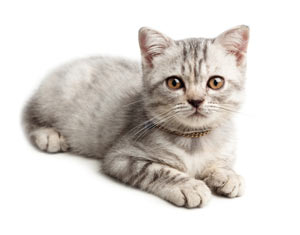FIV: Feline Immunodeficiency Virus

FIV, or feline immunodeficiency virus, is in the same family of viruses as feline leukemia virus (FeLV), although its subfamily, the lentivirus, is different. Lentiviruses are responsible for diseases in many types of animals, including acquired immunodeficiency syndrome (AIDS) in humans, caused by HIV (human immunodeficiency virus). FIV is often referred to as feline AIDS.
Immunodeficiency viruses are specific for the species they infect, and there is no evidence that FIV infects people or HIV infects cats.
FIV-infected cats are found throughout the world. According to the Cornell Feline Health Center, "In the United States, approximately 1.5-3% of healthy cats are infected with FIV." (Cornell University College of Veterinary Medicine)
How Do Cats Become Infected with FIV?
The primary mode of transmission of FIV is through bite wounds. Outdoor cats, especially territorial tomcats, are at the greatest risk of becoming infected. Casual contact among cats sharing food and water dishes is not a significant mode of transmission. Unlike with HIV, sexual contact is probably not a significant way for FIV to be transmitted either. Though it is rare, the virus may be passed from a mother cat to her kitten. Kittens may also be aborted or stillborn if the mother is infected.
What Happens If a Cat Gets FIV?
After infection with FIV, the virus enters the cat's bloodstream. Fever and swollen lymph nodes may be the first signs noted in the early phase of infection, but this can be transient and is easy to miss. The primary target of the virus is the cells of the immune system.
Malfunction of the body's immune system due to FIV infection leads to the development of secondary opportunistic infections, which can cause severe illness and death. This can happen quickly, or infected cats can be normal for months to years before the virus becomes active and the cat shows signs of disease.
FIV infection has been associated with a wide variety of disorders including but not limited to:
- Enlarged lymph nodes
- Ulcers of the tongue and inflamed gums
- Progressive weight loss
- Poor hair coat and skin disease
- Diarrhea
- Anemia
- Eye and nervous system disease
- Cancer
These illnesses all get a foothold by taking advantage of the immune system dysfunction that FIV causes. Microorganisms that are present commonly in the environment are easily controlled by a cat with a normal immune system, but they can cause significant disease in cats with an FIV-damaged immune system.
Diagnosis of FIV in Cats
Diagnosis of FIV in cats is made through blood testing. These tests look for antibodies to FIV in the blood. Identification of FIV-infected cats through testing allows the veterinarian to develop a long-term management plan for cats that are positive. A blood sample is taken from the cat, and the test can be performed in most veterinary offices. Results are usually available within ten minutes. A combination test for FeLV and FIV is available in most facilities.
When testing a cat for FIV, confirming a positive antibody test result is crucial, especially in cats that aren't showing signs of illness, since a portion of uninfected cats may have false positive results. A second test using a different technique can be done in the laboratory to confirm the first positive test. If there is a discrepancy between the two tests, then the cat will need to be retested in about 12 weeks.
False negative tests can occur, though this is rare. It can happen when a cat has a late-stage infection and the immune system is so exhausted that antibodies to FIV are no longer being produced at detectable levels.
Which Cats Should Be Tested for FIV?
Your veterinarian may test cats for FIV in the following cases:
-
Kittens four months of age or older.
- Kittens may have positive test results without actually being infected with the virus because of antibodies that were transferred from a vaccinated or infected mother cat. If kittens that are 6 months old or younger test positive for FIV, retesting should be done every 60 days until they are 6 months old to clarify their true FIV status.
- New cats or kittens being brought into a home should be tested before the negative resident cats are exposed to them.
- A cat that has been bitten by a cat of unknown FIV status should be tested 60 days after the bite occurs.
- Any cat allowed outdoors that develops an illness possibly consistent with FIV should be tested, even if they tested negative in the past.
- Cats allowed outdoors should be tested once a year unless they have been vaccinated (vaccination can interfere with the test results). Consult with your veterinarian in this case.
Is FIV in Cats Treatable?
There is no cure for FIV infection. Although the disease is considered fatal, many infected cats can live for years in relatively good health. Once infections move in, medications can be given to control those secondary conditions. Because of the immune system suppression, longer and more aggressive treatment may be needed for these cats than would be the case for FIV-negative cats with the same infections.
There are no medications or therapies that have been proven to prevent the transition from asymptomatic to symptomatic infection of FIV.
Caring for Your FIV-Positive Cat
Knowing the best ways to care for your FIV-positive cat may help prolong the period of quality time he has before he becomes sick. Following are some important steps to take in the care of the FIV-positive cat:
- Raw, uncooked foods should be avoided in FIV-infected cats due to their increased susceptibility to foodborne bacteria.
- The cat's environment should be kept as clean as possible to cut down on the presence of microorganisms that may cause the immunosuppressed cat trouble.
- FIV-infected cats need to see the veterinarian more frequently than well cats. Wellness visits every 6 months are recommended for these cats. A thorough physical examination, complete blood count, blood chemistry, urinalysis, and fecal examination should be performed as recommended by your veterinarian.
- FIV-positive cats should receive veterinary attention promptly at the first indication of sickness. Accurate and fast identification of a secondary illness is extremely important for successful treatment.
- Vaccination programs to prevent infection by other diseases should be maintained in asymptomatic cats as recommended by your veterinarian.
- Sexually intact cats that have FIV should be altered (neutered) to reduce the stress associated with estrus and mating behaviors.
- If you are unable to quarantine infected cats from healthy cats in your home, confine the infected cat indoors, or bear the costs of the veterinary care that ill cats require, consult with your veterinarian.
If your FIV-positive cat dies and you are bringing a new cat home, complete a careful cleaning process first. While the virus that causes FIV doesn't live long outside of an infected cat's body, the secondary agents that caused the cat's ultimate death may be present at high enough counts in the environment to cause illness in other cats. Replace food and water bowls, bedding, and litter boxes, and clean carpets and floors with an appropriate general cleaner.
Prevention of FIV in Cats
Preventing infection with FIV is the key because there is no way to get rid of it once a cat has it. Cats bitten by infected cats are at highest risk of developing FIV. Keeping your cat indoors alone or with tested negative cats will prevent the type of contact necessary for infection. If you introduce a new cat to your home, an FIV test should be carried out first in order to make sure that the new cat is FIV-negative before he is introduced to the resident cats.
A vaccine for FIV is available but does not prevent infection in all vaccinated cats (it is 60-80% effective after 3 doses). After vaccination, the results of certain diagnostic tests may show positive, so discuss with your veterinarian whether FIV vaccination is appropriate for your cat.
Works Cited
- Cornell University College of Veterinary Medicine. (n.d.). Feline Immunodeficiency Virus. Retrieved from Cornell Feline Health Center: www.vet.cornell.edu/fhc/Health_Information/brochure_fiv.cfm
You May Also Like These Articles:
Upper Respiratory Tract Conditions in Cats
Cats Snoring: Normal or Abnormal?
How to Be Prepared for Your Cat's Veterinary Bills
Bubonic Plague: Cats are Highly Susceptible





